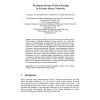Free Online Productivity Tools
i2Speak
i2Symbol
i2OCR
iTex2Img
iWeb2Print
iWeb2Shot
i2Type
iPdf2Split
iPdf2Merge
i2Bopomofo
i2Arabic
i2Style
i2Image
i2PDF
iLatex2Rtf
Sci2ools
102
Voted
NETWORKING
2007
2007
Maximum Energy Welfare Routing in Wireless Sensor Networks
Most routing algorithms for sensor networks focus on finding energy efficient paths to prolong the lifetime of sensor networks. As a result, the sensors on the efficient paths are depleted quickly, and consequently the sensor networks become incapable of monitoring events from some parts of their target areas. In many sensor network applications, the events have uncertainties in positions and generation patterns. Therefore, routing algorithms should be designed to consider not only energy efficiency, but also the amount of energy left in each sensor to avoid sensors running out of power early. This paper introduces a new metric, called Energy-Welfare, devised to consider average and balance of sensors’ remaining energies simultaneously. Using this metric, we design the Maximum Energy Welfare Routing algorithm, which achieves energy efficiency and energy balance of sensor networks simultaneously. Moreover, we demonstrate the effectiveness of the proposed routing algorithm by comparing...
Related Content
| Added | 30 Oct 2010 |
| Updated | 30 Oct 2010 |
| Type | Conference |
| Year | 2007 |
| Where | NETWORKING |
| Authors | Changsoo Ok, Prasenjit Mitra, Seokcheon Lee, Soundar R. T. Kumara |
Comments (0)

